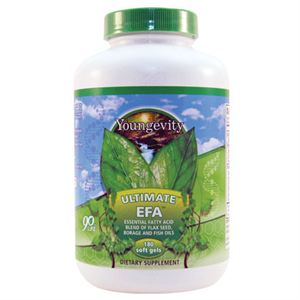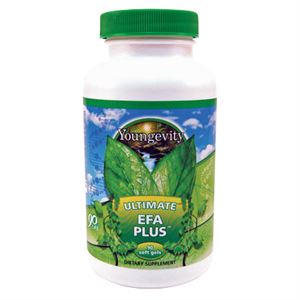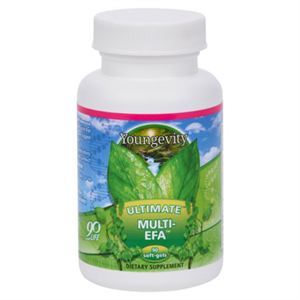Health Tips About EFA's: Inflammation & Omega Vitamins
Inflammation is derived from Omega-6 EFAs (except GLA, which is anti-inflammatory). Anti-inflammation is associated with Omega-3s. Omega-3 containing oils are much harder to find in nature, and are harder to get from the standard American diet, which features vegetable oils derived from Omega-6 grains. It’s generally understood that we should be getting somewhere around 2 or 3 or maybe 4 parts Omega 6 EFAs for every 1 part omega -3 to maintain an optimum relationship between inflammation and anti-inflammation...
Scroll to the bottom to find out more about Omega vitamins, disease,diabetes and Inflammation
Ultimate™ EFA™
A proprietary blend of essential fatty acids from flaxseed, fish and borage oils providing your body with a healthy balance of Omega 3, 6, and 9. Contains: ALA, LA, OA, GLA, DHA.
Omega Spectrum
Omega 3: ALA, DHA
Omega 6: LA, GLA
Omega 9: OA
Sourced From:
Flaxseed, borage and fish oils (Tuna)
Difference
Full spectrum of Omegas
Ultimate™ EFA Plus™
EFA Plus features an exclusive blend of Essential Fatty Acids (Omega 3, 6 and 9) with a high Omega 3 profile; increasing the proprietary blend of essential fatty acids from borage, flax, and fish oils, with added EFAs for extra support. Contains: ALA, LA, OA, GLA, EPA and DHA
Omega Spectrum
Omega 3: ALA, EPA, DHA
Omega 6: LA, GLA
Omega 9: OA
Sourced From:
Flaxseed, borage, Sunflower and fish oils (Anchovy, Sardines, or Pollock)
Difference
Full spectrum of Omegas, but with EPA added for a greater Omega 3 balance
Ultimate Multi-EFA™
A smaller, easy-to-swallow capsule that provides you with Plant Derived EFAs that are neccessary for optimal health of adults and children. These smaller, easy-to-swallow capsules are perfect for kids and are also fish oil free for individuals on a vegetarian diet. Contains: LA and GLA
Omega Spectrum
Omega 3: None
Omega 6: LA, GLA
Omega 9: None
Sourced From:
Plant derived (Evening Primrose Oil)
Difference
No fish Oils, only Omega 6, Smaller capsule size (as big as the fuzzy end of an earwig)
About Omega's and Inflammation
The following is an exert from Ben Fuchs' article on this website "How Proper Nutrition Can Increase Sexual Attractiveness"
The whole nature of anti-inflammation and inflammation, because of its importance and relevance to health and disease, is worth spending a couple moments on. Prostaglandins mediate all inflammatory process and also provide a balance to inflammation. The body is constantly balancing opposing biochemical processes. Excitation and Inhibition of brain cells, contraction and relaxation of muscles and dilation and constriction of blood vessels are all examples of antagonistic processes that occur in the body and that must be controlled and balanced to keep us healthy. You can add inflammation and anti-inflammation to this list as examples of balancing actions that occur in the body.
The prostaglandin control of this balance is mediated by opposing types of prostaglandins. There are pro inflammatory prostaglandins and there are anti-inflammatory prostaglandins. The prostaglandins involved with inflammation are derived from Omega-6 EFAs (with the notable exception of GLA, which is anti-inflammatory) and the ones associated with anti-inflammation are associated with Omega-3s. This is why you’ll hear nutritionists and dieticians associate too much inflammation with excess ingestion of Omega -6 containing oils. Omega-3 containing oils are much harder to find in nature and certainly they are much harder to obtain from the standard American diet, which feature vegetable oils derived from Omega-6 grains. It’s generally understood that we should be getting somewhere around 2 or 3 or maybe 4 parts Omega 6 EFAs for every 1 part omega -3 to maintain an optimum relationship between inflammation and anti-inflammation. EFAs are unusual among essential nutrients in the sense that their complexity makes it difficult to assess individual requirements. In other words, no one really knows how much we need of each, how much we need in total, and what the exact proportion of Omega 6s to omega 3’s is appropriate. In day to day real life, lots of factors influence need. If we’re growing or healing or exercising and building muscle, we need more. If we’re not getting enough anti-oxidant, on the other hand, we should probably be using lower daily doses as these fats are unstable and easily destroyed by oxidation. Sometimes EFAs can be displaced by saturated and/or processed fats, so our EFA needs are increased if we’re eating a lot of trans-, hydrogenated or otherwise processed fats. Some disease states, particularly diabetes, can influence how well Omega 6 can get converted into GLA so that prostaglandins can be made. In other words diabetics may not make this conversion effectively leading to GLA deficiency. This makes essential fatty acids especially important for diabetics or even pre-diabetics (which covers most of us).



